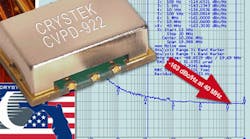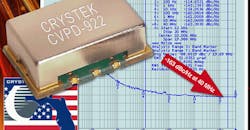Timing is everything, especially in modern wireless communications networks with their millions of users and sophisticated modulation and multiplexing schemes. For current 4G LTE systems and future 5G wireless systems, crystal oscillators are relied upon to maintain that timing, and many fine examples of these devices will be on display at the 2017 IMS exhibition.
Bliley Technologies (booth No. 425) will present its extremely stable Poseidon series of oven-controlled crystal oscillators (OCXOs). Available with sinewave output signals from 5 to 130 MHz and excellent long-term aging, they deliver +13-dBm typical output power into a 50-Ω load. Various options are available for phase noise, with performance as good as ‒170 dBc/Hz offset 100 kHz from the carrier.
This line of LVPECL crystal oscillators works with low voltages and low current consumption. (Courtesy of Crystek)
For those who prefer somewhat less power consumption than required by an OCXO, Crystek Corp. (booth No. 741) will show IMS visitors examples of its advanced voltage-controlled crystal-oscillator (VCXO) technology, including members of its CVPD-922 family of VCXOs (see figure). Available with differential LVPECL outputs from 40 to 125 MHz, these low-power-consumption oscillators exhibit noise floors of ‒162 dBc/Hz and close-in phase noise that has been reduced to ‒85 dBc/Hz offset 10 Hz from a 100-MHz carrier.
Also, Statek Corp. (booth No. 1908) will offer application advice on its low-power CXOXLPN quartz crystal oscillator for output frequencies from 20 to 50 MHz and supply voltages of +1.8 to +3.3 V dc. Available for commercial and military use, the 3.2- × 2.5-mm device features a noise floor at 5-MHz offset from the carrier of ‒162 dBc/Hz and low phase noise of ‒106 dBc/Hz offset 10 Hz from a 25-MHz carrier.


